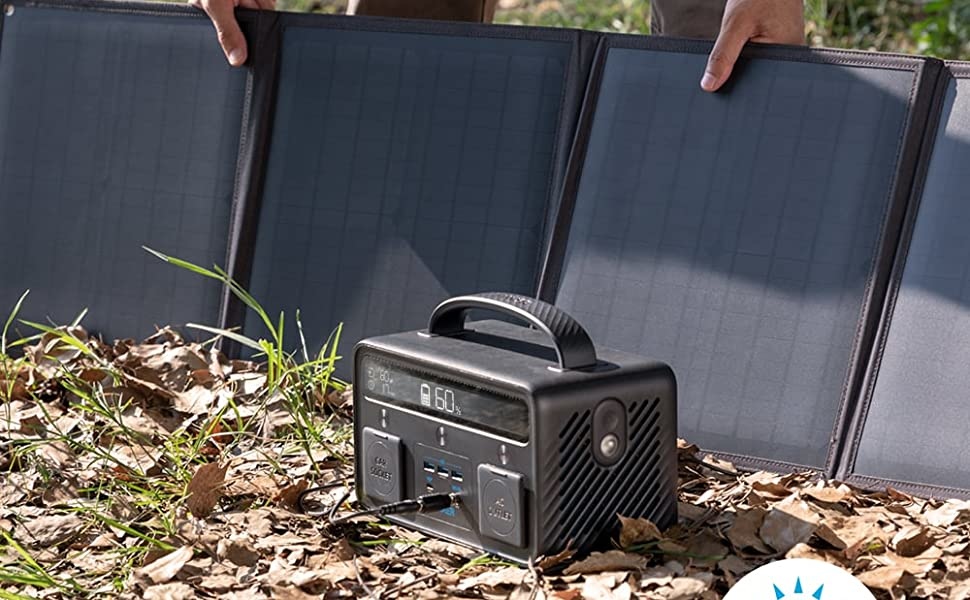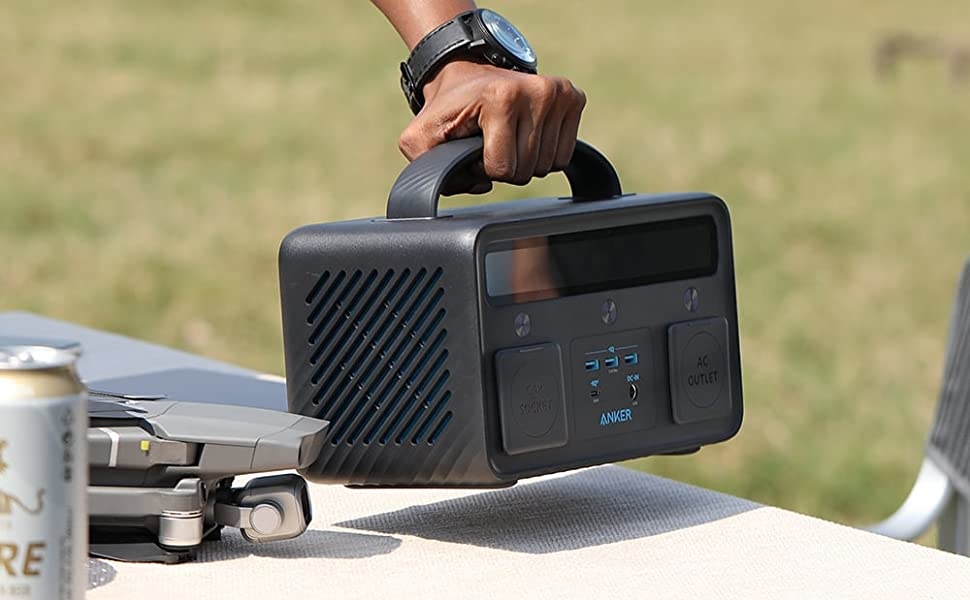If you are someone who spends many hours or even days away from a power source, you know how difficult it can be to keep all your devices properly topped off. With a huge battery and a variety of smart features, the Anker PowerHouse II 300 seeks to remedy that conundrum. In this review, we take a look at the PowerHouse and how it performs.
I've always been a fan of Anker products. The company produces a variety of quality power products, cables, and more at competitive prices, and they have never failed me.

The Anker PowerHouse II 300 (model 523) is essentially a very large battery (289 Wh) inside a convenient portable housing and paired with a variety of useful features and connections for charging devices. To put into perspective how big a 289 Wh battery is, the PowerHouse II 300 can charge a 2020 MacBook Air 3-4 times, an iPad Air 7 times, an iPhone 13 20 times, or a typical camera 16 times. It can also run a mini-fridge for over 5 hours or a typical LED television for about 6 hours.
Specifications
- Capacity: 80,000mAh / 289 Wh Li-ion battery
- Weight: 4.19 kg / 9.24 lbs
- Dimensions: 255 × 148 × 139 mm / 10 × 5.8 × 5.5 in
- Output:
- AC: 110 V, 2.72 A (300 W maximum) at 50 or 60 Hz
- USB-A: 5 V, 7.2 A (2.4 A maximum per port)
- USB-C: 5 V, 3 A / 9 V, 3 A / 15 V, 3 A / 20 V, 3 A (60 W maximum)
- Car socket DC: 12 V, 10A (120 W maximum)
- All ports may be used simultaneously at a maximum of 516 W
- DC input: 65 W maximum
- USB-C input: 60 W maximum
- DC and USB-C input: 125 W maximum
- Note: the PowerHouse can charge via both DC and USB-C until it reaches 81%, after which it will use only DC
- Solar input: 7.9 mm x 0.9 mm male connector
- 8 ports:
- 300 W AC outlet
- 60 W USB-C port
- 3 USB-A ports
- Car socket
- 2 DC ports
- PowerIQ 3.0 USB-C port can charge a 2020 MacBook Air to 50% in about 40 minutes or iPhone 13 to 50% in about 30 minutes
- Built-in flashlight with low brightness, full brightness, and SOS modes
- Built-in LED light with three levels for ambient light
- LED display that shows battery capacity, current input and output status, and estimate recharging time
- Recharging time: 5 hours with standard charger, 3 hours and 20 minutes via fast charging (DC and USB-C)
Contents, Design, and Setup
In the box is the following:
- Anker 523 Portable Power Station
- 65 W adapter
- USB-A to USB-C cable
- USB-C to USB-C cable
- Car port to DC cable
- Welcome guide
The device is characteristic of other Anker products, using a mix of black with blue accents, making it blend in well with the environment. It is quite solid, with a drop-proof unibody structure and a built-in carrying handle that makes it easy to transport. It feels quite rugged and looks nice.
The display is quite nice, with a good backlight and large characters, making it easy to read in just about any situation. In the center is a percentage indicator showing how much charge is remaining in the battery. On the left, the current input wattage and time until full charge is reached are shown, while on the right, the current output wattage and time until complete discharge are shown.

The lights are a particularly well-thought-out touch, with Anker clearly designing them with how they would be used in mind. The flashlight is on the short end so that its throw is parallel to the handle, so it can be easily used while the PowerHouse is being carried. The LED light is on the long side, helping it spread move evenly over a wider area, making it more appropriate for ambient usage.
The ports are easily accessible, with the three USB-A port, USB-C, and DC-in ports sitting in the center. On the left side, the car socket and two DC ports are covered by a rubberized flap, and on the right, the AC outlet is covered by a similar flap. Note that the AC outlet is three-prong, so you don't need to worry about being able to use grounded plugs. I do wish the USB ports came with similar flaps. Of course, it is unlikely you'll be using the device in the rain, but if you take it camping or something, there is always the chance of a random splash or the like.
Usage and Performance
Usage is as straightforward as you would hope. At 9.2 lbs (4.2 kg), the device is hefty but not overly so, and when it comes to batteries, their weight scales as their capacity does, so no one should expect a featherweight device if they want decent capacity.
Both lights are plenty bright for their intended purposes, and the warm temperature of the ambient bar is appreciated. Turn on the lamps or plug a device in and press the respective control button, and the display lights up to display charge remaining, current wattage, and time remaining. I found it quite accurate; I plugged in my 85-watt MacBook Pro charger, and it hovered right around 85 watts the whole time, and more importantly, the charging speed matched that of a permanent outlet. After a few seconds, the display turns off again to conserve power, but you can tap the button to see it again.
While the laptop was plugged in, I added my phone and tablet, and they too charged at maximum speed without issue. It's nice, of course, to not have to set anything manually; the device automatically maximizes charging speed. Note that the AC outlet maxes out at 300 watts, so don't expect to plug something like a space heater into the device, but any electronic device should be completely fine.

Charging the PowerHouse is equally easy. You can plug it into a standard household outlet, use your car's cigarette lighter, use USB-C, or use solar panels. The car option is nice, as you can simply leave it in your vehicle for shoots or trips without having to bring it back and forth or worry about forgetting it. And, of course, with solar, you can charge it totally off the grid and for free. A solar panel that will max out the 65-watt DC input and charge the device in 5 hours is about $100, making it relatively cost-effective and easy to stay on top of heavy power demands even totally off the grid.
So, what does all that capacity add up to? Let's say I go on a shoot with my MacBook Air (52.6 Wh), EOS R5 and four batteries (15 Wh each), iPhone (9.3 Wh), fan for hair (20 W), and Broncolor monolight (72 Wh battery). With a capacity of 289 Wh, I could expect that once I depleted them all, I could charge my laptop, phone, monolight battery, and all four camera batteries once, plus run the fan for around four hours. That's certainly more than enough to get most creatives through a day. Throw in a 60-watt solar panel, and you would have a hard time depleting the device totally. And in reality, even with my plethora of devices, including a laptop, phone, tablet, many camera batteries, fan, purifier, two sets of headphones, and more, my charging needs never came close to outpacing the PowerHouse or my ability to top it off again. It easily keeps up with me on all-day shoots or trips, or if you experience a power outage, you can stay entertained and keep all your essential devices running until it comes back on.
What I Liked
- Ambient light and flashlight are nice conveniences and well thought out
- All-day power at a competitive price
- Variety of ports with fast-charging protocols
- AC, car DC, USB, and solar charging capabilities
- Can be charged via AC and USB simultaneously for shorter charge times
- Clear and easy-to-read informational screen
- Solid build
- Built-in carrying handle
What I Didn't Like
- USB and DC-in ports are unprotected
Conclusion and Purchase
Altogether, the Anker PowerHouse II 300 is a well-built, carefully designed, powerful, and versatile device, making it an easy recommendation. You can purchase yours here. If you have slightly different needs, the closest alternatives are the 521 and 535 models. The 521 model is about $100 cheaper and sacrifices about 10% capacity and can only output at 200 watts over the AC port, but it uses newer LiFePO4 batteries, which have about five times the longevity of Li-ion. The 535 model is $240 more expensive, but adds 70% capacity, more ports, higher output, and uses LiFePO4 batteries.







As mentioned, the AC outlet maxes at 300 watts. Check your strobe's manual for its power draw.
That appears to be a lithium-powered unit. Much better and safer to use a LiFePO4 power supply. For $100 less than the Anker you can get the similarly powered GOLABS R300 LiFePO4 power supply, and for $100 more than the Anker you can get the GOLABS R500 LiFePO4 power supply with almost twice the power.